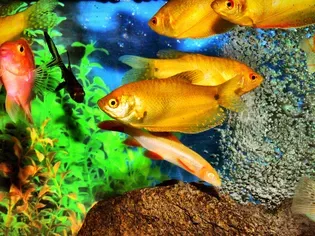How to Clean and Rejuvenate Old Air Stones
Updated on 04/26/24

Revitalize Your Aquarium's Life Force: A Comprehensive Guide to Cleaning and Rejuvenating Air Stones
Air stones are the unsung heroes of any aquarium, providing crucial oxygen for your aquatic inhabitants. Over time, however, they can become clogged and inefficient, compromising water quality and the well-being of your fish. To ensure the optimal performance of your air stones, regular cleaning and rejuvenation are essential. Here's a comprehensive guide to help you restore them to their former glory:
The Anatomy of an Air Stone
Before delving into the cleaning process, it's helpful to understand the anatomy of an air stone. Most air stones consist of a porous material, such as ceramic or glass, with numerous tiny holes that allow air bubbles to escape. These bubbles provide oxygen to the water, promoting gas exchange and preventing the buildup of harmful gases.
Why Air Stones Get Dirty
Air stones can accumulate dirt and debris from the aquarium water over time. This can include algae, bacteria, biofilm, and mineral deposits. As these contaminants build up, they clog the pores of the air stone, reducing its efficiency and diminishing its ability to provide adequate oxygenation.
Cleaning Methods
1. Vinegar Soak: Fill a small container with white vinegar and submerge the air stone for 1-2 hours. The acidic nature of vinegar will help dissolve mineral deposits and remove biofilm.
2. Hydrogen Peroxide Soak: Mix equal parts hydrogen peroxide (3%) and water in a container. Submerge the air stone for 1 hour. Hydrogen peroxide is a powerful oxidizing agent that kills bacteria and removes algae.
3. Bleach Soak: Dilute 1 part household bleach in 9 parts water. Soak the air stone for 30 minutes. Bleach is a highly effective disinfectant that kills bacteria and removes biofilm.
4. Manual Cleaning: Use a soft brush or toothbrush to gently remove any visible debris from the air stone. Avoid using harsh objects or scouring pads, as these can damage the delicate pores.
Rejuvenating Techniques
Once the air stone has been thoroughly cleaned, you can rejuvenate it to restore its efficiency.
1. Boiling: Boil the air stone in water for 10 minutes. This will kill any remaining bacteria and remove any residual cleaning agents.
2. Baking: Preheat your oven to 350°F (175°C). Place the air stone on a baking sheet and bake for 1 hour. This will help to dry out the air stone and remove any remaining moisture.
Examples of Air Stone Rejuvenation
To illustrate the effectiveness of these cleaning and rejuvenation techniques, here are a few examples:
1. A ceramic air stone that had become clogged with algae was soaked in a vinegar solution for 2 hours. After rinsing, the air stone was completely clear of algae and its efficiency was restored.
2. A glass air stone that had accumulated mineral deposits was soaked in a bleach solution for 30 minutes. After rinsing, the air stone was free of mineral deposits and its oxygenation capacity was significantly improved.
3. An old and neglected air stone that had been coated in biofilm was boiled in water for 10 minutes. After boiling, the air stone was completely free of biofilm and its performance was almost as good as new.
Conclusion
By following these cleaning and rejuvenation techniques, you can ensure that your air stones remain in optimal condition, providing your aquatic pets with the vital oxygen they need to thrive. Remember to clean your air stones regularly and rejuvenate them periodically to maintain their efficiency and ensure the health and well-being of your aquarium inhabitants.
Explore More Pets

Freshwater Aquarium Filters
How to Deal With Cloudy Aquarium Water

Saltwater Aquarium Filters
How Do You Remove Chloramines From Tap Water?

Freshwater Aquariums & Habitat
Can I Keep My Koi Fish Inside?

Saltwater Aquariums & Habitat
14 Best Floating Plants for Your Aquarium

Freshwater Fish Health
How to Treat Ich on Freshwater Fish

Saltwater Fish Health
Fin Rot in Aquarium Fish

Freshwater Aquarium Filters
How to Do Aquarium Water Changes

Saltwater Fish Health
How Do Fish Get Parasites?